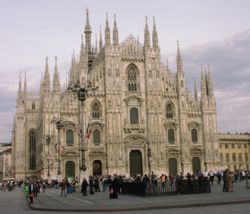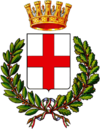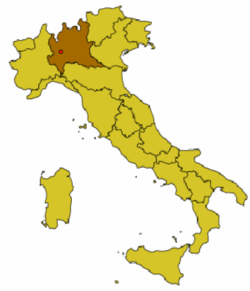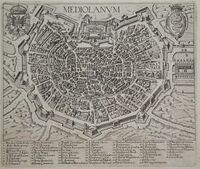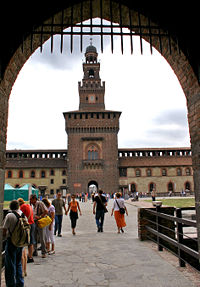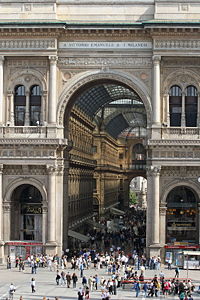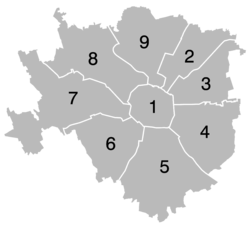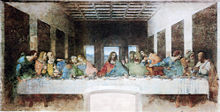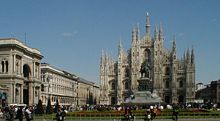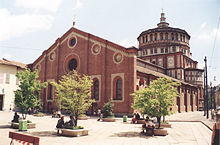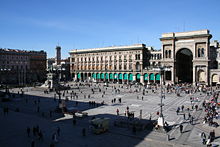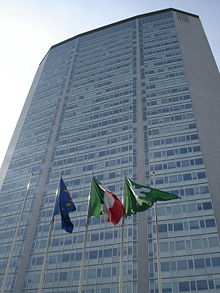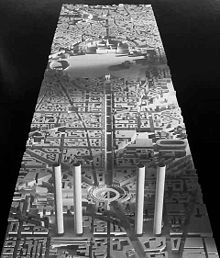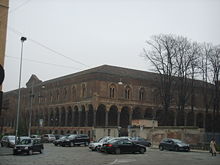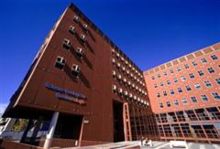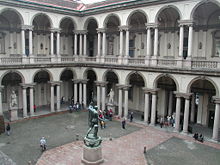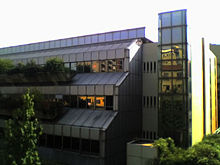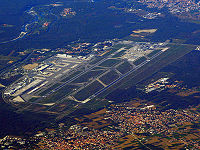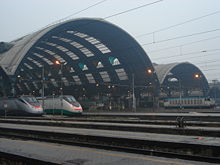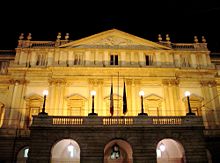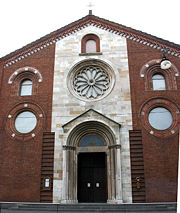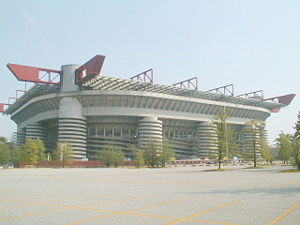Milan
2008/9 Schools Wikipedia Selection. Related subjects: Europe; European Cities
| Comune di Milano | |||
| The Milan Cathedral | |||
|
|||
| Location of the city of Milan | |||
| Coordinates: | |||
|---|---|---|---|
| Sovereign state | Italy | ||
| Region | Lombardy | ||
| Province | Province of Milan | ||
| Insubric settlement | c. 600 BC | ||
| Roman foundation | 222 BC | ||
| Government | |||
| - Mayor | Letizia Moratti | ||
| Area | |||
| - City | 182 km² (70.3 sq mi) | ||
| - Urban | 1,982 km² (765.3 sq mi) | ||
| Elevation | +120 m (394 ft) | ||
| Population (December 2006) | |||
| - City | 1,303,437 ( 2nd) | ||
| - Density | 7,159/km² (18,541.7/sq mi) | ||
| - Metro | 7.4 million | ||
| - Called | Milanesi or Meneghini | ||
| Time zone | CET ( UTC+1) | ||
| - Summer ( DST) | CEST ( UTC+2) | ||
| Postal codes | 20100, 20121-20162 | ||
| Area code(s) | 02 | ||
| Patron saints | Ambrose ( 7 December) | ||
| Website: www.comune.milano.it | |||
Milan ( Italian: Milano; Western Lombard: Milan (listen)) is one of the largest cities in Italy, located in the plains of Lombardy. The municipality (Comune di Milano) has a population of 1.3 million. The Milan metropolitan area, depending on the specific definition, has a population ranging from 2.9 to 7.4 million. The municipal border covers a relatively small area (about one-eighth of that of Rome) because of the historical development of high density centres in agriculturally rich Lombardy.
Milan is renowned as one of the world capitals of design and fashion. The English word milliner is derived from the name of the city. The Lombard metropolis is famous for its fashion houses and shops (such as along via Montenapoleone) and the Galleria Vittorio Emanuele in the Piazza Duomo (reputed to be the world's oldest shopping mall). The city hosted the World Exposition in 1906 and will host the Universal Expo in 2015. Inhabitants of Milan are referred to as "Milanese" (Italian: Milanesi or informally Meneghini or Ambrosiani).
The Olona river, the Lambro river and the Seveso creek run through Milan. Olona and Seveso run mostly underground.
History
Etymology
The Celtic name for the settlement of the Insubres is not attested, but in the Roman name Mediolanum the name element -lanum is the Celtic equivalent of -planum "plain'", thus Mediolanum: "in the midst of the plain", due to its location in a plain close to the confluence of two small rivers, the Olona and the Seveso. The origin of the name and of a boar as a symbol of the city are fancifully accounted for in Andrea Alciato's Emblemata (1584), beneath a woodcut of the first raising of the city walls, where a boar is seen lifted from the excavation, and the etymology of Mediolanum given as "half-wool", explained in Latin and in French. The foundation of Milan is credited to two Celtic peoples, the Bituriges and the Aedui, having as their emblems a ram and a boar; therefore "The city’s symbol is a wool-bearing boar, an animal of double form, here with sharp bristles, there with sleek wool." Alciato credits the most saintly and learned Ambrose for his account.
The German name for the city is Mailand, while in the local Western Lombard dialect, the city's name is Milán, similar to the French.
Roman times
Around 400 BC, the Celtic Insubres inhabited Milan and the surrounding region. In 222 BC, the Romans conquered this settlement, which received the name Mediolanum. After several centuries of Roman control, Milan was declared the capital of the Western Roman Empire by Emperor Diocletian in 293 AD. Diocletian chose to stay in the Eastern Roman Empire (capital Nicomedia) and his colleague Maximianus the Western one. Immediately Maximinian built several gigantic monuments, like a large circus (470 x 85 meters), the Thermae Erculee, a large complex of imperial palaces and several other services and buildings.
In the Edict of Milan of 313, Emperor Constantine I guaranteed freedom of religion for Christians. The city was besieged by the Visigoths in 402, and the imperial residence was moved to Ravenna. Fifty years later (in 452), the Huns overran the city. In 539, the Ostrogoths conquered and destroyed Milan in the course of the so-called Gothic War against Byzantine Emperor Justinian I. In the summer of 569, the Longobards (from which the name of the Italian region Lombardy derives) conquered Milan, overpowering the small Byzantine army left for its defence. Milan surrendered to the Franks in 774 when Charlemagne, in an utterly novel decision, took the title "King of the Lombards" as well (before then the Germanic kingdoms had frequently conquered each other, but none had adopted the title of King of another people). Subsequently Milan was part of the Holy Roman Empire.
Middle Ages
During the Middle Ages, Milan prospered as a centre of trade due to its command of the rich plain of the Po and routes from Italy across the Alps. The war of conquest by Frederick I Barbarossa against the Lombard cities brought the destruction of much of Milan in 1162. After the founding of the Lombard League in 1167, Milan took the leading role in this alliance. As a result of the independence that the Lombard cities gained in the Peace of Constance in 1183, Milan became a duchy. In 1208 Rambertino Buvalelli served a term as podestà of the city, in 1242 Luca Grimaldi, and in 1282 Luchetto Gattilusio. In 1395, Gian Galeazzo Visconti became duke of Milan. In 1447 Filippo Maria Visconti, Duke of Milan, died without a male heir; following the end of the Visconti line, the Ambrosian Republic was enacted. However, the Republic collapsed when in 1450, Milan was conquered by Francesco Sforza, of the House of Sforza, which made Milan one of the leading cities of the Italian Renaissance.
Periods of Spanish, French and Austrian domination
The French king Louis XII first laid claim to the duchy in 1492. At that time, Milan was defended by Swiss mercenaries. After the victory of Louis’s successor Francis I over the Swiss at the Battle of Marignano, the duchy was promised to the French king Francis I. When the Habsburg Charles V defeated Francis I at the Battle of Pavia in 1525, northern Italy, including Milan, passed to the House of Habsburg. In 1556, Charles V abdicated in favour of his son Philip II and his brother Ferdinand I. Charles’s Italian possessions, including Milan, passed to Philip II and the Spanish line of Habsburgs, while Ferdinand’s Austrian line of Habsburgs ruled the Holy Roman Empire.
However, in 1700 the Spanish line of Habsburgs was extinguished with the death of Charles II. After his death, the War of the Spanish Succession began in 1701 with the occupation of all Spanish possessions by French troops backing the claim of the French Philippe of Anjou to the Spanish throne. In 1706, the French were defeated in Ramillies and Turin and were forced to yield northern Italy to the Austrian Habsburgs. In 1713, the Treaty of Utrecht formally confirmed Austrian sovereignty over most of Spain’s Italian possessions including Lombardy and its capital, Milan.
19th Century
Napoleon conquered Lombardy in 1796, and Milan was declared capital of the Cisalpine Republic. Later, he declared Milan capital of the Reign of Italy and was crowned in the Duomo. Once Napoleon’s occupation ended, the Congress of Vienna returned Lombardy, and Milan, along with the Veneto, to Austrian control in 1815. During this period, Milan became a centre of lyric opera. Here Mozart wrote three operas, and in a few years La Scala became the reference theatre in the world, with its premieres of Bellini, Donizetti, Rossini and Verdi. Verdi himself is now tumulated in a precious Institute, the "Casa di Riposo per Musicisti", the Verdi's present to Milan. In the 19th century other important theatres were La Cannobiana and the Teatro Carcano.
On March 18, 1848, the Milanese rebelled against Austrian rule, during the so-called " Five Days" (It. Cinque Giornate), and Field Marshall Radetzky was forced to withdraw from the city temporarily. However, after defeating Italian forces at Custoza on July 24, Radetzky was able to reassert Austrian control over Milan and northern Italy. However, Italian nationalists, championed by the Kingdom of Sardinia, called for the removal of Austria in the interest of Italian unification. Sardinia and France formed an alliance and defeated Austria at the Battle of Solferino in 1859. Following this battle, Milan and the rest of Lombardy were incorporated into the Kingdom of Sardinia, which soon gained control of most of Italy and in 1861 was rechristened as the Kingdom of Italy.
The political unification of Italy cemented Milan’s commercial dominance over northern Italy. It also led to a flurry of railway construction that made Milan the rail hub of northern Italy. Rapid industrialization put Milan at the centre of Italy’s leading industrial region, though in the 1890s Milan was shaken by the Bava-Beccaris massacre, a riot related to an high inflation rate. Meanwhile, as Milanese banks dominated Italy’s financial sphere, the city became the country’s leading financial centre. Milan’s economic growth brought a rapid expansion in the city’s area and population during the late 19th and early 20th centuries.
20th Century
In 1919, Benito Mussolini organized the Blackshirts, who formed the core of Italy’s Fascist movement, in Milan. In 1922, Mussolini started his March on Rome from Milan.
During World War II, Milan suffered severe damage from British and American bombing, Even though Italy quit the war in 1943, the Germans occupied most of northern Italy until 1945. Some of the worst Allied bombing of Milan was in 1944. Much of the bombing focused around Milan's main train station.
In 1943, anti-German resistance in occupied Italy increased and there were explosions in Milan.
As the war came to an end, the American 1st Armored Division advanced on Milan as part of the Po Valley Campaign. But even before they arrived, members of the Italian resistance movement rose up in open revolt in Milan and liberated the city. Nearby, Mussolini and several members of his Italian Social Republic (Repubblica Sociale Italiana, or RSI) were captured by the resistance at Dongo and executed. On 29 April 1945, the bodies of the Fascists were taken to Milan and hung unceremoniously upside-down at Piazzale loreto a public square.
After the war the city was the site of a refugee camp for Jews fleeing from Austria. During the 1950s and 1960s, thousands of Italians, particularly from Southern Italy, moved to Milan to seek jobs within the city’s rapidly expanding economy and the population peaked at 1,723,000 in 1971. From the 1980s Milan become to host many immigrants from other countries of third world. In the same years began the quick and great extension of Chinatown, a district established in the 20s in the area around Via Paolo Sarpi, Via Bramante, Via Messina and Via Rosmini, by a group of chinese people from Zejiang. Today is one of the most picturesque district in the city. Much of Milan's population however was lost during the 1970s and 1980s to the belt of new suburbs and small cities surrounding Milan. Nonetheless, Milan’s population seems to have stabilized, and there has been a slight increase in the population of the city since 2001.
Municipal Administration
Politics
- Name of the Mayor: Letizia Brichetto Arnaboldi in Moratti
- Date of election: May 30, 2006
- Party: Forza Italia - Popolo delle Libertà
Of nine boroughs into which Milan is divided, eight are governed by centre-right coalition (1-8) and one by centre-left coalition (9).
Administrative Subdivision
The city of Milan is subdivided into 9 administrative zones, called Zona. In 1999 the administration decided to reduce the number of these zones from 21 to 9. The Zona 1 is in the historic centre - within the perimeter of the spanish-era city walls, the other eight cover from Zona 1 borders to the city limits..
The following table reports the datas for every Zona; the total population is higher than the official city population because it includes foreign born immigrants with permits in its count.
| Zona | Area (km²) |
Population (31 December 2006) |
Density (inhab/km²) |
Subdivisions | |
| Zona 1 | Centro Storico | 9.67 | 107,087 | 11,074 | Centro Storico, Piazza del Duomo, Porta Tenaglia, Porta Sempione / Arco della Pace, Chinatown, Giardini Pubblici, piazza della Repubblica, largo della Crocetta, via della Guastalla, Basilica di Sant'Ambrogio, San Vittore, Parco delle Basiliche, Carrobbio |
| Zona 2 | Stazione Centrale, Gorla, Turro, Precotto, Greco, Crescenzago | 12.58 | 163,932 | 13,031 | Porta Nuova, Centrale, Ponte Seveso, Loreto, Maggiolina, Villaggio dei Giornalisti, Greco, Gorla, Turro, Precotto, Padova, Crescenzago, Adriano, Breda, Cassina di Pomm |
| Zona 3 | Porta Venezia, Città Studi, Lambrate | 14.23 | 153,470 | 10,785 | Porta Venezia, Porta Monforte, Città Studi, Lambrate, Parco Lambro, Ortica, Quartiere Feltre, Casoretto, via Corelli, Rottole, Cimiano, via Carnia, Naviglio della Martesana |
| Zona 4 | Porta Vittoria, Porta Romana, Forlanini, Monlué, Rogoredo | 20.95 | 169,051 | 8,069 | Porta Vittoria, Porta Romana, piazzale Libia, Cavriano, Calvairate, Monluè, Taliedo, La Trecca, Porto, Gamboloita, Nosedo, piazzale Corvetto, Rogoredo, Santa Giulia, Morsenchio, Forlanini, viale Omero, San Luigi, Ponte Lambro |
| Zona 5 | Porta Ticinese, Porta Lodovica, Vigentino, Chiaravalle, Gratosoglio | 29.87 | 134,016 | 4,487 | Porta Ticinese, Porta Lodovica, Vigentino, Chiaravalle, Gratosoglio, Porta Vigentina, Conchetta, parco Ravizza, piazza Ohm, via Ripamonti, Vigentino, viale Ortles, via Quaranta, Morivione, via Spaventa, Quartiere Stadera, Quartiere Torretta, via Meda, Conca Fallata, Vaiano Valle, Selvanesco, Casenuove, Macconago, Quintosole, Ronchetto delle Rane, Chiesa Rossa, Naviglio Pavese, Vettabbia, corso San Gottardo |
| Zona 6 | Barona, Giambellino, Lorenteggio, Porta Genova | 18.28 | 164,487 | 8,998 | Porta Genova, Darsena, via Magolfa, via Solari, San Cristoforo, Moncucco, Lorenteggio, via Giambellino, Restocco Maroni, Ronchetto sul Naviglio, Boffalora, Cascina Bianca, Cascina Cantalupa, via Bisceglie, via Inganni, piazza Frattini, Naviglio Grande, Barona, via Santa Rita, viale Legioni Romane, via Foppa |
| Zona 7 | Porta Vercellina, Baggio, San Siro, Forze Armate | 31.34 | 190,969 | 6,093 | Porta Vercellina, Baggio, San Siro, via delle Forze Armate, Porta Vercellina, piazzale Aquileia, piazza Piemonte, via Washington, via Marghera, piazzale Brescia, piazzale Siena, via Saint Bon, Ospedale San Carlo, via Valsesia, Quinto Romano, Quarto Cagnino, piazzale Selinunte, Figino, Assiano, Muggiano, via Novara, via Marx, via Bellaria, via degli Ippodromi |
| Zona 8 | Porta Volta, Fiera, Gallaratese, Quarto Oggiaro | 23.72 | 197,484 | 8,326 | Porta Volta, Fiera, Gallaratese, Quarto Oggiaro, corso Sempione, Bullona, Cimitero Monumentale, Porta Garibaldi, via Cenisio, via Paolo Sarpi, Ghisolfa, Cagnola, Il Portello, Monte Stella, Boldinasco, Q.T.8, piazza Bonola, via Ghisallo, Trenno, Lampugnano, San Leonardo, piazzale Accursio, Musocco, Porta Volta, Villapizzone, Garegnano e Certosa di Garegnano, Vialba, Quarto Oggiaro, Belgioioso, Roserio |
| Zona 9 | Affori, Porta Nuova, Niguarda, Bovisa, Fulvio Testi | 21.12 | 194,386 | 9,204 | Affori, Porta Nuova, Niguarda, Bovisa, viale Fulvio Testi, Centro Direzionale, via Melchiorre Gioia, L'Isola, viale Zara, via Lancetti (Dogana), via Farini, Bovisasca, Dergano, Derganino, Montalbino, Prato Centenaro, Cà Granda, Comasina, Segnano, Bicocca, Stazione di Milano Greco Pirelli, viale Sarca, viale Fermi, via Astesani, piazzale Maciachini, Bruzzano, Parco Nord, via Seveso |
| Total City | 181,76 | 1,483,882 | 8,164 |
Climate
Under the Köppen climate classification Milan is typically classified as having a Humid subtropical climate (Cfa). In contrast to most of Italy, which is famous for a comfortable Mediterranean climate, Milan's winters are typically damp and cold, while summers are warm and quite muggy at times. Average temperatures are -3/+6°C in January and +15/+28°C in July. Snowfalls are relatively common in winter, even if in the last 15-20 years they have decreased in frequency and amount. The historic average of Milan's area is between 35 and 45 cm (16"/18"); single snowfalls over 30-50 cm in 1-3 days happen periodically, with a record of 80-100 cm during the famous snowfall of January 1985. Humidity is quite high during the whole year and annual precipitation averages about 1000 mm (40 in). In the stereotypical image, the city is often shrouded in the fog characteristic of the Po Basin, although the removal of rice fields from the southern neighbourhoods, urban heating effect and the reduction of pollution levels have reduced this phenomenon in recent years, at least in the downtown.
| Weather averages for Milan | |||||||||||||
|---|---|---|---|---|---|---|---|---|---|---|---|---|---|
| Month | Jan | Feb | Mar | Apr | May | Jun | Jul | Aug | Sep | Oct | Nov | Dec | Year |
| Average high °C (°F) | 6 (44) | 8 (47) | 13 (56) | 16 (62) | 21 (70) | 25 (77) | 28 (83) | 28 (82) | 24 (75) | 17 (64) | 11 (52) | 7 (45) | 17 (63) |
| Average low °C (°F) | -4 (25) | -3 (27) | 1 (34) | 4 (40) | 9 (49) | 12 (55) | 15 (60) | 15 (60) | 12 (54) | 6 (44) | 0 (33) | -3 (26) | 5 (42) |
| Precipitation cm (inches) | 5 (2.0) | 6 (2.4) | 8 (3.5) | 12 (4.9) | 12 (4.9) | 8 (3.5) | 6 (2.5) | 8 (3.5) | 6 (2.7) | 8 (3.3) | 10 (4.2) | 5 (2.0) | 97 (38.3) |
| Source: Weatherbase 2008 | |||||||||||||
Main sights
Milan is one of the major artistic centres of northern Italy. Its chief landmarks include:
- The Duomo, the world's largest collection of marble statues with the widely visible golden Madonna statue on top of the spire, la Madunina (little Madonna), the symbol of Milan.
- Teatro alla Scala. Milan is also one of the most important centres in the world for Opera lirica, with his famous Teatro alla Scala ( La Scala).
- The Galleria Vittorio Emanuele II, a large, covered arcade linking the Duomo's piazza with the Teatro alla Scala.
- The Castello Sforzesco
- The Basilica of Sant'Ambrogio
- The Palaeo-Christian Basilica of San Lorenzo
- The Biblioteca Ambrosiana, containing drawings and notebooks by Leonardo da Vinci among its vast holdings of books, manuscripts, and drawings, and is one of the main repositories of European culture. The city is also the home of the Brera Academy of Fine Arts.
- The church of Santa Maria delle Grazie, which houses one of the most famous paintings of Leonardo da Vinci, The Last Supper (L'ultima cena or Il cenacolo).
- The church of Santa Maria presso San Satiro, with a famous trompe l'oeil traditionally ascribed to Bramante
- The Cimitero Monumentale di Milano.
- The Pinacoteca di Brera, Pinacoteca Ambrosiana, Poldi Pezzoli, the Bagatti Valsecchi Museum and the Musei del Castello galleries, which host a great number of pictorial masterpieces.
Demographics
The city proper (Comune di Milano) has a population of 1,303,437 inhabitants (2006). Between 1991 to 2001, the city proper has lost 113,084 inhabitants (8.3 percent), mostly due to suburban sprawl and expulsion of population from the inner city centre, which is now almost fully dedicated to offices and commerce. The population of the urban area, that coincides with the Province of Milan, is estimated as of 2006 to be 3,884,481 . Finally, the official population of the Milan Metropolitan area counts over 7.4 million residents, the largest in Italy . As of 2006, the Italian national institute of statistics ISTAT estimated that 292,204 foreign-born immigrants live in Milan Urban Area, equal to 7.6% of total population.
Economy
Milan is one of the major financial and business centres of the world. The city is the seat of the Italian Stock Exchange (the Borsa Italiana) "Piazza Affari" and its hinterland is an avant-garde industrial area. Milan was included in a list of ten " Alpha world cities" by Peter J. Taylor and Robert E. Lang of the Brookings Institution in the economic report "U.S. Cities in the 'World City Network'" ( Key Findings, Full Report PDF (940 KiB)).
Milan is also well-known as the seat of the Alfa Romeo motorcar company, for its silk production, and as one of the world's capitals for fashion and a world leader for design.
Milan also provides directional functions for the whole of Lombardy, as its industrial base has been externalized throughout the region in the 1960s-70s.
FieraMilano, the city's Exhibition Centre and Trade Fair complex, is notable. The original fairground, known as "FieraMilanoCity", is slated for redevelopment. The new fairground, in the north-western suburb of Rho, opened in April 2005, making the Fiera Milano the largest trade fair complex in the world.
Milan of the future
At present, Milan is experiencing a significant architectural and urban design renaissance. Many new construction projects are under way with the aim of rehabilitating disused, peripheral industrial areas, including entire quarters. Examples of these projects include: the addition to the Teatro alla Scala; the CityLife project in the old "fiera" site; the new quarter Santa Giulia; and the Porta Nuova project in the Garibaldi-Repubblica zone. Famous architects are involved in the construction of this "new" Milan, such as Renzo Piano, Norman Foster, Zaha Hadid, Massimiliano Fuksas and Daniel Libeskind. These major works will give Milan a new skyline no longer dominated by the Duomo and the Pirelli Tower.
This urban rebirth will continue due to the selection of Milan to host Expo 2015.
Education
Milan is home to numerous universities and other institutions of higher learning:
Science and medical
- Vita-Salute San Raffaele University
- Tethys Research Institute
Architecture and engineering
- Politecnico di Milano
Business, economic and social
- Bocconi University
- Scuola Superiore di Direzione Aziendale – Bocconi
Language, art and music
- Accademia d’Arti e Mestieri dello Spettacolo alla Scala
- Brera Academy Academy of Fine Arts of Brera
- Università I.U.L.M.
- Nuova Accademia di Belle Arti Milano - NABA
- Conservatorio Superiore "G. Verdi" di Milano
- Scuola Beato Angelico
Fashion and design
- Domus Academy, Postgraduate School of Design
- Istituto Europeo di Design
- Istituto Marangoni
- Politecnico di Milano - Facoltà del Design
- SPD Scuola Politecnica Di Design
Other
- I.S.E.F. Milano – Centro accademico sportivo "Rino Fenaroli"
Transportation
Airports
The city has a large international airport known as Malpensa International Airport (MXP), located near the industrial towns of Busto Arsizio and Gallarate and connected to the downtown with the "Malpensa Express" railway service (from Cadorna Station and central station ). Malpensa was designed by the famous Ettore Sottsass. Milan also has the Linate Airport (LIN) within the city limits (for European and domestic traffic), connected with bus line 73 (from S. Babila). A third airport is Orio al Serio (BGY), close to the city of Bergamo. Vergiate, Venegono, Bresso, Voghera and Montichiari are additional airports in the region.
Subways, tramways, trolleybuses and buses
Milan has 3 subway lines (M1 – red, M2 – green, M3 – yellow) and the system, called Milan Metro – "La Metro", running for more than 80 km. There is also a light metro-service, "Metrò S. Raffaele", connecting the San Raffaele Hospital with Cascina Gobba station (M2). Extensions of lines 1, 2 and 3 are under construction, to create more than 15 km of track with 10 new stations. Line 5 is also under construction, to be finished in the first half of 2012. Lines 4 (linking downtown with Linate Airport) and 6 are in planning stages.
The "Passante" is a railway tunnel under the city centre used by suburban trains, and allow passengers coming from suburbs a direct interchange to the three (soon to be four) metro lines at Garibaldi, Repubblica, Porta Venezia and Rogoredo stations.
Greater Milan also has one of the most extensive tramway systems in the world, with more than 286 km of track, and 20 lines.
Milan also has four trolleybus routes; included in the fleet are ten air-conditioned Cristalis trolleybuses.
Ninety-three bus lines cover over 1,070 km between them. The local transportation authority (ATM) transported more than 600 million passengers in 2003 .
Railways
Milan is the second railway hub of Italy, and the five major stations of Milan, amongst which the Milan Central station, are among Italy's busiest. The first railroad built in Milan, the Milan and Monza Rail Road was opened for service on August 17, 1840.
High speed train lines are under construction all across Italy, and new lines will open from Milan to Rome and Naples, and from Milan to Torino.
Other than the Central Station, High Speed Trains will sometimes stop also at:
- Milano Rogoredo (for trains coming from Bologna and Rome)
- Milano/Rho Fiera (from Turin)
- Milano Pioltello (from the planned high speed line from Venice)
Regional-Metropolitan Railway services
The Suburban Railway Service ( "S" Lines, a service similar to the French RER and German S-Bahn), composed of eight suburban lines and ten more scheduled for 2008, connects the "Greater Milan" to cities such as Como and Varese. The Regional Railway Service ("R"), instead, links Milan with the rest of Lombardy and the national railway system. The "Passante ferroviario" is an underground railway serving a couple of "S" lines and is very much like another subway line (and is even marked as such on subway maps), except that it is connected to LeNord and Trenitalia suburban networks. See the map of the M (subway) + S (regional metropolitan railway) Network on msrmilano.com Go on
Taxis
Milan has a taxi service operated by private companies and licensed by the City of Milan (Comune di Milano). All taxis are the same colour, white. Prices are based on time elapsed and distance traveled. As the number of licences is kept low by lobbying of present taxi drivers and finding a taxi may be difficult in rush hours, and almost impossible during public transportation strikes.
Culture
Literature
In the late eighteenth century, and throughout the nineteenth, Milan was an important centre for intellectual discussion and literary creativity. The Enlightenment found here a fertile ground. Cesare Beccaria, with his famous Dei delitti e delle pene, and Pietro Verri, with the periodical Il Caffè were able to exert a considerable influence over the new middle-class culture, thanks also to an open-minded Austrian administration. In the first years of the nineteenth century, the ideals of the Romantic movement made their impact on the cultural life of the city and its major writers debated the primacy of Classical versus Romantic poetry. Here, too, Giuseppe Parini, and Ugo Foscolo published their most important works, and were admired by younger poets as masters of ethics, as well as of literary craftmanship. Foscolo's poem Dei sepolcri was inspired by a Napoleonic law which—against the will of many of its inhabitants—was being extended to the city.
In the third decade of the nineteenth century, Alessandro Manzoni wrote his novel I Promessi Sposi, a Milanese story of the XVII century, etc.. This historical novel was the real manifesto of Italian Romanticism, which found in Milan its centre. The periodical Il Conciliatore published articles by Silvio Pellico, Giovanni Berchet, Ludovico di Breme, who were both Romantic in poetry and patriotic in politics.
After the Unification of Italy in 1861, Milan lost its political importance; nevertheless it retained a sort of central position in cultural debates. New ideas and movements from other countries of Europe were accepted and discussed: thus Realism and Naturalism gave birth to an Italian movement, Verismo. The greatest verista novelist, Giovanni Verga, was born in Sicily but wrote his most important books in Milan.
Language
In addition to Italian, approximately a third of the population of western Lombardy can speak the Western Lombard language, also known as Insubric. In Milan, some natives of the city can speak the traditional Milanese language—that is to say the urban variety of Western Lombard, which is not to be confused with the Milanese-influenced regional variety of the Italian language.
Religion
Milan's population, like that of Italy as a whole, is overwhelmingly Catholic. Other religions practised include Buddhism, Judaism, Islam and Protestantism. It is the seat of the Roman Catholic Archdiocese of Milan.
Milan has its own historic Catholic rite known as the Ambrosian Rite (it: rito ambrosiano). It varies slightly from the typical Catholic rite (the Roman, used in all other western regions), with some differences in the liturgy and mass celebrations, and in the calendar (for example, the date of carnival is celebrated some days after the common date). The Ambrosian rite is also practised in other surrounding locations in Lombardy and in the Swiss canton of Ticino.
Another important difference concerns the liturgical music. The Gregorian chant was completely unused in Milan and surrounding areas, because the official one was its own Ambrosian chant, definitively established by the Council of Trent (1545-1563) and earlier than the Gregorian . To preserve this music there has developed the unique schola cantorum, a college, and an Institute in partnership with the "Pontifical Ambrosian Institute of Sacred Music" (PIAMS) in Rome .
Food
Like most cities in Italy, Milan and its surrounding area has its own regional cuisine. Milanese cuisine includes " cotoletta alla milanese", a breaded veal (pork and turkey can be used) cutlet pan-fried in butter (which some claim to be of Austrian origin, as it is similar to Viennese "Wienerschnitzel", while others claim that the "Wienerschnitzel" derived from the "cotoletta alla milanese"). Other typical dishes are cassoeula (stewed pork rib chops and sausage with Savoy cabbage and tomato sauce), ossobuco (stewed veal shank with tomato or lemon sauce), risotto alla milanese (with saffron, white wine and beef marrow), busecca (stewed tripe with beans and tomato sauce), and brasato (stewed beef or pork with wine and potatoes). Season-related pastries include chiacchiere (flat fritters dusted with sugar) and tortelli (fried spherical cookies) for Carnival, colomba (glazed cake shaped as a dove) for Easter, pane dei morti ("Bread of the Dead", cookies aromatized with cinnamon) for All Soul's Day and panettone for Christmas. The salame milano, a salami with a very fine grain, is widespread throughout Italy. The best known Milanese cheese is gorgonzola from the nearby town of that name, although today the major gorgonzola producers operate in Piedmont.
Sports
The city hosted, among other events, the FIFA World Cup in 1934 and 1990, the UEFA European Football Championship in 1980.
Football is the most popular sport in Italy, and Milan is home to two world-famous football teams: A.C. Milan and Internazionale. The former is normally referred to as "Mìlan" (notice the stress on the first syllable, unlike the English and Milanese name of the city), the latter as "Inter".
Milan is the only city in Europe whose teams have won both the European Cup and the Intercontinental Cup. Both teams play at Giuseppe Meazza – San Siro Stadium (85,700). Many of the strongest Italian football players were born in Milan, in the surrounding metropolitan area, or in Lombardy: Valentino Mazzola, Paolo Maldini, Giuseppe Meazza, Giacinto Facchetti, Luigi Riva, Gaetano Scirea, Giuseppe Bergomi, Walter Zenga, Antonio Cabrini, Roberto Donadoni, Gianluca Vialli, Silvio Piola, Gabriele Oriali, Giovanni Trapattoni and Franco Baresi as well as many others.
- The famous Monza Formula One circuit is located near the city, inside a wide park. It is one of the world's oldest car racing circuits. The capacity for the F1 races is currently around 137,000 spectators, although in the 1950s the stands could hold more than 250,000. It has hosted an F1 race nearly every year since the first year of competition, with the exception of 1980.
- Olimpia Milano (sponsored Armani) is a successful Italian and European basketball team. It is one of the most important and successful Italian teams and also one of the top teams in Europe too. Olimpia plays at the DatchForum arena (capacity 14,000).
- Rhinos Milano American Football Club is the oldest American football club in Milan and has won four Italian Super Bowls. They are one of the five foundation clubs of the Italian Football League.
- CUS Milano Baseball is the oldest baseball club in Milan and has won eight Italian Scudetti.
- The Amatori Rugby Milano has won 18 National Championships and are the most famous and important Rugby team in Italy.
- Different ice hockey teams from Milan have won 30 National Championships between them. The Vipers Milano have won the last 5 national championships, the Alpenliga and several Coppa Italia, and are the leaders of that sport in Italy. They play at the Agora Stadium (capacity 4,500) during the regular season, and at the Forum during playoffs.
- Every year, Milan hosts the Bonfiglio Trophy Under 18 Tennis Tournament. It is the most important youth tournament in the world, and is played at the Milan Tennis Club. The central court has a capacity of 8000. Past winners include Tacchini, Jan Kodes, Adriano Panatta, Corrado Barazzutti, Moreno, Björn Borg, Smid, Ivan Lendl, Guy Forget, Jim Courier, Goran Ivanišević, Yevgeny Kafelnikov, and Guillermo Coria.
Milan and Lombardy are official candidates for the Summer Olympic Games of 2020 ("Milan-Lombardy 2020").
Stadia
- Autodromo Nazionale Monza – car and motorcycle racing – 137,000
- San Siro – only football; Milan and Inter – 85,700
- Arena Civica – Athletics, Rugby, Football, American Football 30,000
- Brianteo – Athletics, Football – 18,568
- Ippodromo del Trotter – Horse Racing – 16,000
- Ippodromo del Galoppo – Horse Racing – 15,000
- Datch Forum – Basketball, Ice Hockey, Volleyball, Music – 9,000 to 12,000
- MazdaPalace – Basketball, Volleyball – 9,000
- Velodromo Vigorelli – Cycling, American Football – 12,000
- PalaLido – Basketball, Volleyball – 5,000
- Agorà – Ice Hockey – 4,000
- Nuovo Giuriati – Rugby – 4,000
There are other stadiums and multiuse palaces located in the metropolitan area, the biggest being Monza Brianteo Stadium (18,000 seats), the PalaDesio (10,000) and Geas Stadium (8,500).
| Club | League | Sport | Venue | Established | Championships |
|---|---|---|---|---|---|
| A.C. Milan | Serie A | Football | San Siro – Giuseppe Meazza | 1899 | 4 World Club cups; 7 European championship; 17 Italian championship; 2 Cup Winners' Cup |
| F.C. Internazionale Milano | Serie A | Football | San Siro – Giuseppe Meazza | 1908 | 2 World Club cups; 2 European championship; 16 Italian championship; 3 UEFA Cups |
| Olimpia Milano | Serie A | Basketball | Datchforum | 1936 | 1 World cup; 3 European championship; 25 Italian championship; 3 Cup Winners' Cup; 2 Korac cup |
| H.C. Milano/Milano Vipers | Serie A | Ice Hockey | Agorà | 1924 | 2 European championship; 20 Italian championship |
| H.C. Diavoli/Devils today settled in Courmayeur | Serie A | Ice Hockey | – | 1930 | 3 European championship; 7 Italian championship |
| Amatori Rugby Milano | Serie B | Rugby | Stadio Giuriati | 1928 | 18 Italian championship |
| Rhinos Milano | Serie A2 | American Football | Velodromo Vigorelli-Maspes | 1977 | 4 Italian championship |
Parks and gardens
- Orto Botanico di Brera, a historic botanical garden
- Orto Botanico di Cascina Rosa, a new botanical garden
- Parco Sempione, in ancient times the park of the Castello Sforzesco
Sister cities
Milan is twinned with the following cities:
 Bethlehem, Palestinian Authority
Bethlehem, Palestinian Authority Birmingham, United Kingdom
Birmingham, United Kingdom Chicago, USA
Chicago, USA Dakar, Senegal
Dakar, Senegal Frankfurt, Germany
Frankfurt, Germany Guadalajara, Mexico
Guadalajara, Mexico Krakow, Poland
Krakow, Poland Lyon, France
Lyon, France Melbourne, Australia
Melbourne, Australia Osaka, Japan
Osaka, Japan Saint Petersburg, Russia
Saint Petersburg, Russia Sao Paulo, Brazil
Sao Paulo, Brazil Shanghai, People's Republic of China
Shanghai, People's Republic of China Tel Aviv, Israel
Tel Aviv, Israel Toronto, Canada
Toronto, Canada
Other forms of cooperation and city friendship:
 Amman, Jordan
Amman, Jordan Bangkok, Thailand
Bangkok, Thailand Belgrade, Serbia
Belgrade, Serbia Belo Horizonte, Brazil
Belo Horizonte, Brazil Buenos Aires, Argentina
Buenos Aires, Argentina Daegu, South Korea
Daegu, South Korea Lima, Peru
Lima, Peru Medellín, Colombia
Medellín, Colombia Minsk, Belarus
Minsk, Belarus Montreal, Canada
Montreal, Canada Sofia, Bulgaria
Sofia, Bulgaria Ulaan Baataar, Mongolia
Ulaan Baataar, Mongolia Zagreb, Croatia.
Zagreb, Croatia.
